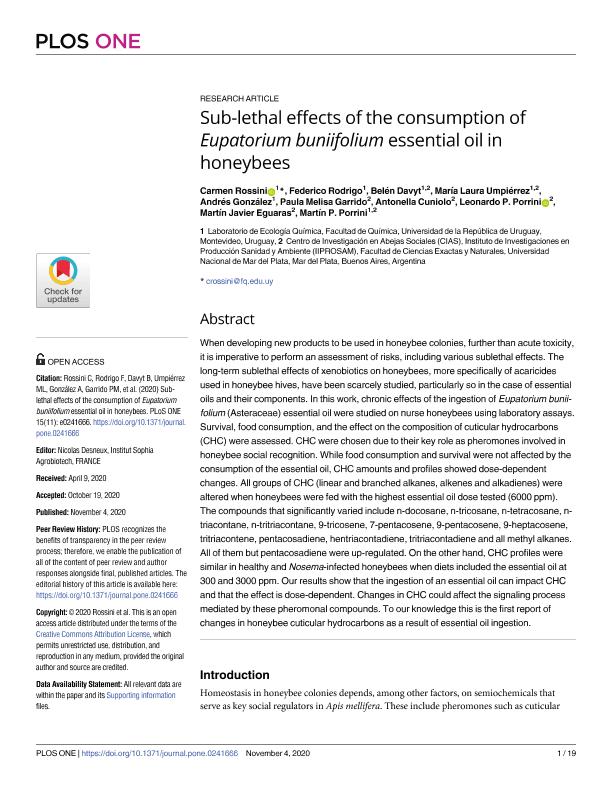Artículo
Sub-lethal effects of the consumption of Eupatorium buniifolium essential oil in honeybees
Rossini, Carmen; Rodrigo, Federico; Davyt Colo, Belén ; Umpiérrez, Maria Laura; González, Andrés; Garrido, Paula Melisa
; Umpiérrez, Maria Laura; González, Andrés; Garrido, Paula Melisa ; Cuniolo, Antonella
; Cuniolo, Antonella ; Porrini, Leonardo Pablo
; Porrini, Leonardo Pablo ; Eguaras, Martin Javier
; Eguaras, Martin Javier ; Porrini, Martín Pablo
; Porrini, Martín Pablo
 ; Umpiérrez, Maria Laura; González, Andrés; Garrido, Paula Melisa
; Umpiérrez, Maria Laura; González, Andrés; Garrido, Paula Melisa ; Cuniolo, Antonella
; Cuniolo, Antonella ; Porrini, Leonardo Pablo
; Porrini, Leonardo Pablo ; Eguaras, Martin Javier
; Eguaras, Martin Javier ; Porrini, Martín Pablo
; Porrini, Martín Pablo
Fecha de publicación:
11/2020
Editorial:
Public Library of Science
Revista:
Plos One
ISSN:
1932-6203
Idioma:
Inglés
Tipo de recurso:
Artículo publicado
Clasificación temática:
Resumen
When developing new products to be used in honeybee colonies, further than acute toxicity,it is imperative to perform an assessment of risks, including various sublethal effects. Thelong-term sublethal effects of xenobiotics on honeybees, more specifically of acaricidesused in honeybee hives, have been scarcely studied, particularly so in the case of essentialoils and their components. In this work, chronic effects of the ingestion of Eupatorium buniifolium(Asteraceae) essential oil were studied on nurse honeybees using laboratory assays.Survival, food consumption, and the effect on the composition of cuticular hydrocarbons(CHC) were assessed. CHC were chosen due to their key role as pheromones involved inhoneybee social recognition. While food consumption and survival were not affected by theconsumption of the essential oil, CHC amounts and profiles showed dose-dependentchanges. All groups of CHC (linear and branched alkanes, alkenes and alkadienes) werealtered when honeybees were fed with the highest essential oil dose tested (6000 ppm).The compounds that significantly varied include n-docosane, n-tricosane, n-tetracosane, ntriacontane,n-tritriacontane, 9-tricosene, 7-pentacosene, 9-pentacosene, 9-heptacosene,tritriacontene, pentacosadiene, hentriacontadiene, tritriacontadiene and all methyl alkanes.All of them but pentacosadiene were up-regulated. On the other hand, CHC profiles weresimilar in healthy and Nosema-infected honeybees when diets included the essential oil at300 and 3000 ppm. Our results show that the ingestion of an essential oil can impact CHCand that the effect is dose-dependent. Changes in CHC could affect the signaling processmediated by these pheromonal compounds. To our knowledge this is the first report ofchanges in honeybee cuticular hydrocarbons as a result of essential oil ingestion.
Palabras clave:
APIS MELLIFERA
,
ESSENTIAL OILS
,
TOXICITY
,
SEMIOCHEMICALS
Archivos asociados
Licencia
Identificadores
Colecciones
Articulos (IIPROSAM)
Articulos de INSTITUTO DE INVESTIGACIONES EN PRODUCCION, SANIDAD Y AMBIENTE
Articulos de INSTITUTO DE INVESTIGACIONES EN PRODUCCION, SANIDAD Y AMBIENTE
Articulos(CCT - MAR DEL PLATA)
Articulos de CTRO.CIENTIFICO TECNOL.CONICET - MAR DEL PLATA
Articulos de CTRO.CIENTIFICO TECNOL.CONICET - MAR DEL PLATA
Citación
Rossini, Carmen; Rodrigo, Federico; Davyt Colo, Belén; Umpiérrez, Maria Laura; González, Andrés; et al.; Sub-lethal effects of the consumption of Eupatorium buniifolium essential oil in honeybees; Public Library of Science; Plos One; 15; 11; 11-2020; 1-19
Compartir
Altmétricas



